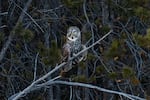
A great gray owl perches beside an open meadow near Sunriver, Ore., Friday, March 26, 2021, after being released from the wildlife hospital. The owl struck a residential window, which caused hemorrhaging behind his eye.
Bradley W. Parks / OPB
Laura Acevedo and Sally Compton teamed up to carry the large crate to the middle of a grassy meadow near Sunriver in Central Oregon. The moon overhead was gaining strength as trees swallowed the sun.
Inside the crate, one of the forest’s most elusive creatures — a great gray owl — flipped and flopped, eager to return to the wild after several days on the mend at Think Wild, a nonprofit wildlife hospital in Bend.
“You want these guys to be really feisty on their way out,” said Acevedo, a veterinarian who volunteers at Think Wild.
“It tells me that they’re doing well, and the most important thing is that they haven’t habituated to people.”
Compton, Think Wild’s director, gave a quick thumbs up to the few folks on-hand, spread out in the meadow, before opening the crate door. The great gray owl burst from the enclosure, soared across the field and gracefully perched on a nearby tree.
Related: In search of great gray owls, ghosts of the forest
It was a welcome sight to Donna Harris and her partner, Kermit Williams, who found the owl about a week prior.
The couple are avid birders and had been watching two great gray owls hunt near Sunriver when the window strike occurred. Harris said they saw the owls disappear into the forest and, as the couple made their way home, heard yelling from a nearby house.
“I know the homeowner, and she said, ‘The owl struck the window! What are we gonna do? We need to call Donna Harris,’” recalled Harris, a retired veterinarian. “And I said, ‘I’m here! Here I am!’”
They located the injured bird and safely put him in a warm, dark crate to try to calm him down. Harris said another birder nearby had the number to the Sunriver Nature Center, which then arranged transport for the owl to Think Wild.
“Everybody was there at the right time and the right circumstance,” Harris said.
Great gray owls are an enigma wrapped in a mystery.
The birds nest high in older forests and are nocturnal, so are rarely seen. They’re large, but, as the Audubon Society describes, even that is an illusion; their fluffy plumage makes them seem bigger than they really are.
The owl is listed as a sensitive species in the Oregon Conservation Strategy, which state wildlife managers use as a guide for conserving animal and plant life.
“A lot of birders like to call them the ‘gray ghost’ because it’s very hard to find them and when you do, it’s kind of a good-kept secret,” said Pauline Baker, Think Wild’s director of wildlife rehabilitation. “Not a lot of people like to tell other people where they see great gray owls.”
The great gray that came into Think Wild’s care had mild hemorrhaging in the back of his eye, which is indicative of head trauma, Baker said. The hospital treated him with an anti-inflammatory medication to minimize visual deficits possibly incurred from the hemorrhage, so they could be sure the owl could hunt.
He passed all his tests, which included capturing live prey, clearing him for discharge Friday.

Think Wild director of wildlife rehabilitation Pauline Baker examines a great gray owl at Think Wild wildlife hospital in Bend, Ore., Friday, March 26, 2021, before the owl's discharge. The owl had to pass a series of tests, including capturing live prey, before he was ready to return to the wild.
Bradley W. Parks / OPB
Window strikes are common, Baker said, but the case of this ethereal bird highlights humans’ role in protecting wildlife.
“Birds really can’t see windows as barriers,” Baker said. “It’s not absorbed in their eyes, so they just don’t see it as a barrier, and they’ll hit it head on.”
Window decals, specialized tape and turning off unnecessary lights at night can all help reduce window strikes. The Portland Audubon has a handy list of tips for preparing your home for the benefit of birds.
Back in the meadow, the owl calmly sat on his perch patiently watching the four humans patiently watching him. They’d all played a role in returning him to the wild.
While the humans started to retreat to their vehicles, the great gray leaped from the tree and took flight — an encouraging sign of recovery.
“Well, I’m glad to see it flying,” said Harris, the retired vet who found the owl. “That’s what veterinary practice is all about is taking in something injured and that could be suffering ... and being able to see them recover. It’s always a very good feeling.”
